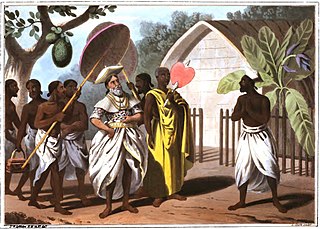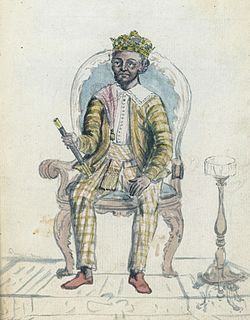Related Research Articles

The Kandyan Wars refers generally to the period of warfare between the British colonial forces and the Kingdom of Kandy, on the island of what is now Sri Lanka, between 1796 and 1818. More specifically it is used to describe the expeditionary campaigns of the British Army in the Kingdom of Kandy in 1803 and 1815.

Sri Vikrama Rajasinha was the last of four Kings, to rule the last Sinhalese monarchy of the Kingdom of Kandy in Sri Lanka. The Nayak Kings were of Telugu origin who practiced Shaivite Hinduism and were patrons of Theravada Buddhism. The Nayak rulers played a huge role in reviving Buddhism in the island. They spoke Telugu or Tamil, and used Tamil as the court language in Kandy alongside Sinhala.

Radala refers to a small minority group in Sri Lanka in the former provinces of the Kingdom of Kandy, who are either descendants of chiefs and courtiers of the King of Kandy or descendants of native headmen appointed by the British colonial administration following the Uva Rebellion in 1818.
Randoli were consorts of royal blood in the harem of the Kings of the Kingdom of Kandy in Sri Lanka. Kandyan Kings maintained a harem, in addition to a chief queen and one or two secondary queens.

The Nayaks of Kandy were the rulers of the Kingdom of Kandy between 1739 and 1815, and the last dynasty to rule on the island. The term Nayak is derived from the Sanskrit word Nāyaka. Their rise to power came about as a result of the death of Vira Narendrasinha, who left no legitimate heir- the throne passed to his brother-in-law, who was crowned as Sri Vijaya Rajasinha in 1739. They were of Telugu origin, spoke Telugu or Tamil, and used Sinhala and Tamil as their court languages.
Bangaru Thirumalai Nayak, also known as Bangaru Tirumalai and Vangaru Thirumala, was a member of Madurai Nayak royal family and Governor/Commander of the Madurai Nayak King Vijaya Ranga Chokkanatha (1704–1731). His son, a young boy was adopted and crowned to the Madurai Throne, with the queen Meenakshi as queen regent, when the Madurai king died without heir. Strife between Bangaru Thirumalai and queen Meenakshi would later erupt into many battles leading to the downfall of the dynasty. Later, through marriage alliances with the Sinhalese royalty, relatives of Bangaru Thirumala came to rule the Kandy kingdom in Sri Lanka. They ruled till 1815 when the last king, Sri Vikrama Rajasinha was deposed and taken captive by the British. He was exiled to Vellore Fort from Kandy.

The Kingdom of Kandy was a monarchy on the island of Sri Lanka, located in the central and eastern portion of the island. It was founded in the late 15th century and endured until the early 19th century.

Vimaladharmasūriya I was a king of Kandy from 1590 to 1604. His reputation was built when he successfully repulsed two major Portuguese offensives on Kandy, the Battle of Danture in 1594 and the Battle of Balana in 1602, in both of which the Portuguese were humiliatingly defeated.

Kirti Sri Rajasinha was the second Nayaka king of Kandy. He was a prince from the Madurai Nayak Dynasty and the brother-in-law of Sri Vijaya Raja Singha. He succeeded his brother-in-law to the throne in 1751.

Sri Rajadhi Rajasinha was a member of the Madurai royal family and succeeded his brother, Kirti Sri Rajasinha as King of Kandy in 1782.
Vimaladharmasurya II was a king of Kandy who succeeded his father, Rajasinghe II. He allowed Joseph Vaz to settle in his kingdom and allowed him to preach the Christian faith.
Senarath Adahasin was king of the Kingdom of Kandy from 1604 to 1635. He is said to be the successor to king Wimaladharmasuriya I of Kandy. However first hand accounts are not available concerning what happened after the death of Vimaladharmasuriya I. He is said to be a cousin or brother of Vimaladharmasuriya according to most sources. He was not a legitimate ruler hence he married not only the deceased king’s widow Dona Katherina but also her two daughters, in order to legitimize his claim to the throne.

The Royal Palace of Kandy, located to the north of the Temple of the Tooth in Kandy, was the royal residence of the Sri Lankan monarchy of the Kingdom of Kandy in Sri Lanka. The last king to reside in it was King Sri Vikrama Rajasinha (1798–1815). Once part of a large palace complex that included the King's Palace, Royal Audience Hall, Queen's Palace, King's Harem Quarters and Queen's Bathing Pavilion (Ulpange), together with the Temple of the Tooth. Adjacent to the Royal Palace is the Victorian era building that until recently housed Kandy High Court.
Sri Vira Parakrama Narendra Singha was the last Sinhalese King of Sri Lanka of the Kingdom of Kandy. He was also known as the "Prince of Kundasale".
The Vijayabā Kollaya took place in the Kingdom of Kotte in 1521. The three sons of the reigning king Vijayabahu VI mutinied against their father, killing him, and divided the Kingdom among themselves. The three sons were products of the king's first marriage and were named Bhuvanekabahu, Pararajasingha and Mayadunne. Queen Kiravella, whom the king married second, had a son named Deva Rajasinghe by her previous marriage. The princes overheard that the king intended to make Devaraja the heir to the throne, at the request of his second queen, and became hostile to the king, and hired a foreigner to murder the king in the palace.

The National Museum of Kandy in Kandy, Sri Lanka is located next to the Temple of the Tooth in part of the former Royal Palace of Kandy. The primary exhibits are housed in the Palle Vahala building, which was the former home of the King's harem. A secondary exhibition is located in the main palace building. The museum is maintained by the Department of National Museums.
Vijayabahu VI was the son of Vira Parakrama Bahu VIII, who was an adopted child of Parakrama Bahu VI who founded the Kingdom of Kotte. He was born in c. 1445 and grew up with his brothers Sri Rajasinghe, Dharma Parakramabahu IX, and Raigam Bandara. He also had a sister who was married to Manamperi Arachchi.

Weliwita Asaranasarana Sri Saranankara Sangharaja Thero or popularly Weliwita Sri Saranankara Thero was a Buddhist monk, who was the last Sangharaja of Sri Lanka. He was the pioneer in the revival in Sri Lanka of Buddhism in Sri Lanka, after the decline of the religion in the 17th and 18th centuries. Saranankara Thero was bestowed with the a title by king Kirthi Sri Rajasinghe in 1753, the same year he received the Upasampada and re-established the Upasampada in Sri Lanka with the help of Mahasangha in Siam. He is also credited with the establishment of Silvath Samagama, a union of monks who lived in accordance with the Buddhist monastic discipline.
Kandyan law is the customary law that originates from the Kingdom of Kandy, which is applicable to Sri Lankans who are Buddhist and from the former provinces of the Kandyan Kingdom. It is one of three customary laws which are still in use in Sri Lanka. The other two customary laws are the Thesavalamai and the Muslim law. At present it governs aspects of marriage, adoption, transfer of property and inheritance, as codified in 1938 in the Kandyan Law Declaration and Amendment Ordinance.

The Kandyan period covers the history of Sri Lanka from 1597–1815. After the fall of the Kingdom of Kotte, the Kandyan Kingdom was the last Independent monarchy of Sri Lanka. The Kingdom played a major role throughout the history of Sri Lanka. It was founded in 1476. The kingdom located in the central part of Sri Lanka managed to remain independent from both the Portuguese and Dutch rule who controlled coastal parts of Sri Lanka; however, it was colonised by the British in 1815.
References
- ↑ Fernando, A. Denis N. (1986). "ANCIENT MAPS OF SRI LANKA—as a Primary Source of Information for the Study of HUMAN SETTLEMENTS AND POLITICAL BOUNDARIES". Journal of the Royal Asiatic Society Sri Lanka Branch. 31: 82–114.
- ↑ Vimaladharma, Kapila Pathirana (2000). "FAMILY GENEALOGIES IN THE STUDY OF PRE-COLONIAL KANDYAN SOCIETY AND POLITY". Journal of the Royal Asiatic Society of Sri Lanka. 45: 93–128.
- ↑ Vimaladharma, Kapila Pathirana (2002). "Journal of the Royal Asiatic Society of Sri Lanka - Google Books". Journal of the Royal Asiatic Society of Sri Lanka. 45–46.